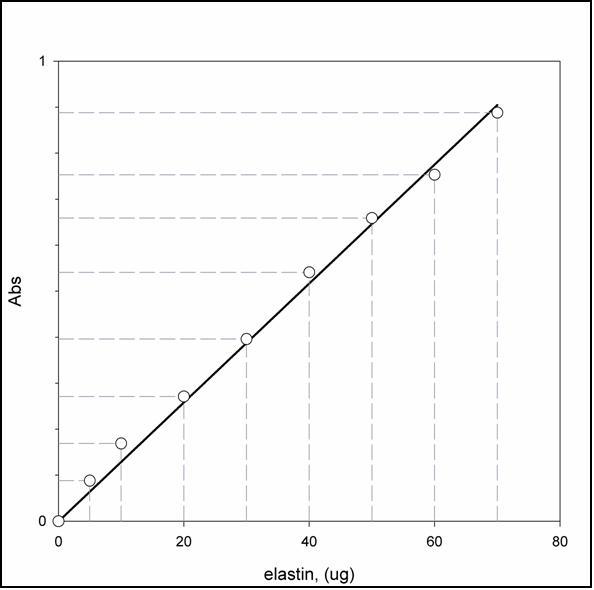Cat # changed from RBCF2000 to F2000
Type
Colorimetric assay
Applications
Cell culture and/or animal studies, Tissue extract, Cell
Sample Requirements
A sample volume of between 50 and 500 μl is required, containing not less than 5 μg and not more than 70 μg elastin.
Shipping
At ambient temperature. Upon receipt, store the product at the temperature recommended below.
Storage/Expiration
Store the kit at RT or 2–8°C. Under these conditions, the kit is stable until the expiration date (see label on the box).
Calibration Curve
Calibration Range
5 – 70 μg
Limit of Detection
5 μg
Features
- The Fastin™ Elastin Assay is a quantitative dye-binding method for the analysis of elastins released into tissue culture medium and extracted from biological materials.
- Elastin forms that can be measured by the Fastin Assay as α-elastin:
- - soluble tropoelastins;
- - lathyrogenic elastins;
- - insoluble elastins (following solubilization to elastin polypeptides [α-elastin, κ-elastin])
- The Fastin Elastin Assay is a quantitative dye-binding method for the analysis of elastins extracted from mammalian sources.
- The dye label employed is 5,10,15,20-tetraphenyl-21H,23H-porphine tetra-sulfonate (TPPS).
- Assay run time - 4 hours
- Manufactured by Biocolor.
Research topic
Extracellular matrix, Animal studies
Summary
Elastin is a key extracellular matrix protein that is critical to the elasticity and resilience of many vertebrate tissues including large arteries, lung, ligament, tendon, skin, and elastic cartilage. Tropoelastin associates with multiple tropoelastin molecules during the major phase of elastogenesis through coacervation, where this process is directed by the precise patterning of mostly alternating hydrophobic and hydrophilic sequences that dictate intermolecular alignment. Massively crosslinked arrays of tropoelastin (typically in association with microfibrils) contribute to tissue structural integrity and biomechanics through persistent flexibility, allowing for repeated stretch and relaxation cycles that critically depend on hydrated environments. Elastin sequences interact with multiple proteins found in or colocalized with microfibrils, and bind to elastogenic cell surface receptors. Knowledge of the major stages in elastin assembly has facilitated the construction of in vitro models of elastogenesis, leading to the identification of precise molecular regions that are critical to elastin-based protein interactions.

